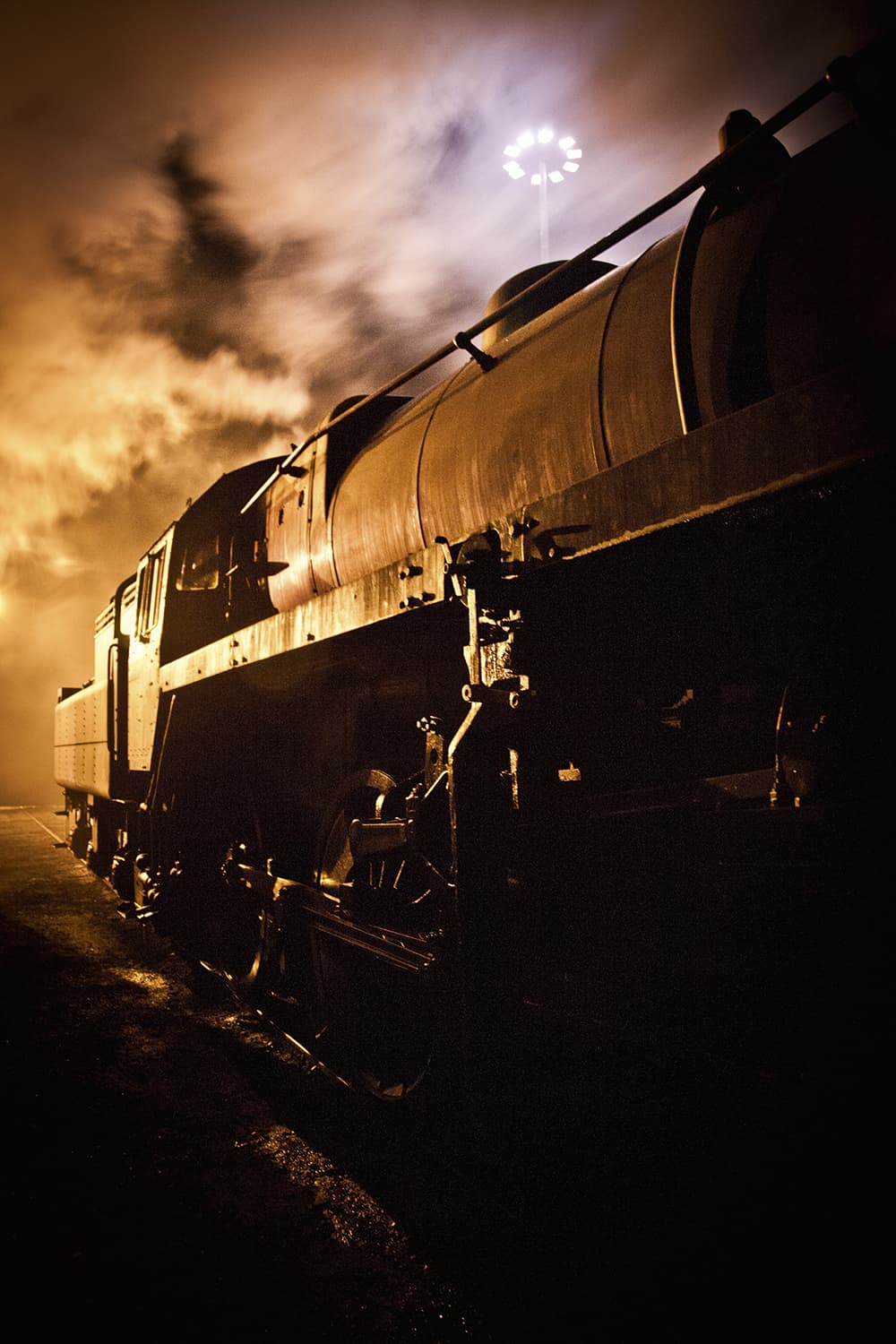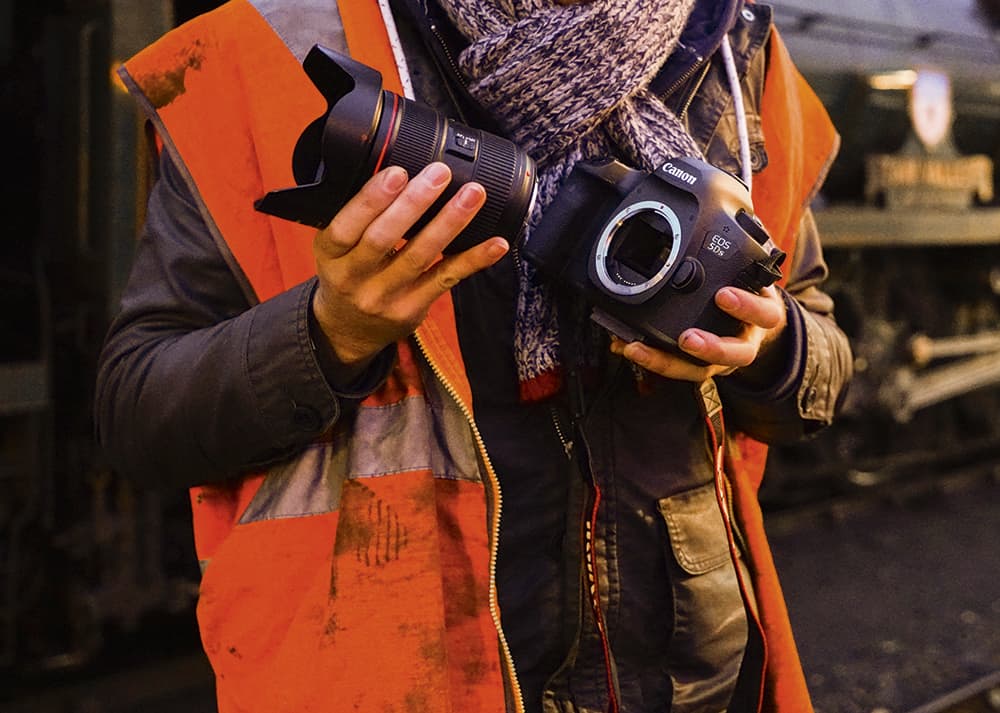
You won’t want to carry unnecessary kit on a night shoot. A standard zoom lens and a wideangle zoom should suffice for most types of shot. Here, a wideangle zoom was used to accentuate the corridor between the steam locomotives simmering in the shed
There are many photographers who will tell you that late autumn and early spring are the best times of the year to get out with your camera. While it’s great to get up at the crack of dawn in order to shoot an early morning sunrise or head out late into the evening to capture a spectacular sunset, there’s also a lot of satisfaction to be had from capturing a great shot in the dark winter months, which always seem to present a much greater challenge.
My passion for heading out into the dark on a cold winter night with my camera kit in tow started a few years back when I passed a preserved steam railway, which just so happened to be running steam locomotives throughout the night. Not really knowing what to expect, I immediately fell in love with the timeless atmosphere, the lingering steam, open coal fires and all the smaller details that made it feel as if I was living in a bygone age. I got so enthralled by it all I stayed for hours, experimenting with the length of my exposures to capture the essence of everything that was happening around me. Returning home to find that I’d made an error of judgment in a few shots made me want to return and give it a second attempt – something I did with greater success. Just like any expert who takes years to refine their skill, I have made endless visits to preserved railways during the hours of darkness since, in an effort to learn the skills required to master railway photography at night using my Canon DSLR.
The challenges
It’s relatively easy to freeze a steam locomotive in its tracks and capture a sharp image during the day using a fast shutter speed, but it all gets a bit more complicated at night. You’ll need your location and subject to be lit up like a football stadium if you’re to achieve a pin-sharp, noise-free image of a steam engine travelling at speed, so you’re better off concentrating your efforts on stationary locomotives and the smaller details that’ll allow you to refine your technique and composition. A preserved railway station is a great place to start and in the darkest winter months you’ll usually get a few attempts to shoot the last trains of the day pausing briefly in the station. There’s more to getting the shot than simply rolling up at your local station, though. You’ll want to research the timetable first to ensure you’re in the right place at the right time – and you’ll find that most preserved railways publish this information on their websites so you can plan ahead before you arrive.
Equipment
My experience of shooting railways at night has taught me to only carry what is absolutely necessary. Heavy and cumbersome telephoto lenses can be left at home and alongside my Canon DSLR, I pack a standard 24-70mm zoom and a wideangle lens should I find myself shooting in a confined area. You’ll want to pack spare memory cards and batteries – it never ceases to amaze me how many frames I end up taking to get ‘the shot’ and if you’re working in extremely cold temperatures your batteries will have a tendency to discharge quicker than normal. By packing the bare essentials, you’ll be able to fit your kit in a shoulder bag and not be weighed down by a cumbersome backpack that can get covered in coal dust and oil when it’s put down in an engine shed. The other two items you won’t want to leave home without are your trusty tripod and cable release.

Old engine sheds are full of atmosphere and can present fantastic opportunities. My settings were 1/4sec @ f/4, ISO 800
Getting set up
Once you have identified a scene that looks like it’ll make a great shot, you’ll need to get set up. After attaching your camera to your tripod you’ll want to think carefully about the composition. Use the rule of thirds and don’t forget to ask yourself whether the shot would look better in the landscape or portrait format. Frame up through the viewfinder and lock the camera off tightly. Failure to do so could result in the camera slipping during an exposure and cause unwanted blur that could ultimately ruin a shot. Attach your cable release and switch the camera on to check it fires the shutter. Next comes the challenge of focusing and getting the exposure spot on.
Autofocus
Focusing in a dark environment is a great test of a camera’s autofocus system. To ensure you get pin-sharp results at night there are a few simple steps you’ll want to follow. Check your lens is set to AF first before setting the autofocus mode on your DSLR to One Shot, which will prevent the camera focusing continuously. Next, set the AF area mode to Spot AF. If you find your lens is hunting or your camera is having difficulty focusing, try positioning the AF point over a light source – station and engine lamps are effective.
By enabling the AF Beep on your camera, you’ll also be able to listen for when you acquire correct focus. Carefully setting the lens to MF will then lock the focus and prevent your camera attempting to obtain focus every time you fire the shutter. You’ll want to repeat these actions each time you compose a new shot otherwise there’s a risk your next shot won’t be pin sharp.
Camera settings
There are no strict rules for getting a perfect exposure and your settings will vary depending on the scene and how light or dark it is. In twilight, for example, you’ll be able to use a lower ISO than you would in an extremely dark scene with minimal light. My experience has told me not to use too long a shutter speed where possible. Shoot with a lengthy 25 to 30-second exposure and you run the risk of steam shrouding the locomotive and it’ll take longer to write the data to the card. Trains can move without warning, so you will increase your chances of bagging the shot with a slightly faster shutter speed. A shutter speed of around 6-15 seconds is recommended. Setting the camera to Shutter Priority (Tv) mode and dialling in a shutter speed of 10 seconds with the ISO set to 800 is a good place to start.
I aim to shoot with an aperture of around f/5.6-f/11 to ensure the depth of field isn’t too shallow in my images and that I preserve good edge-to-edge sharpness throughout the frame. There will be times, however, when you need to push beyond ISO 800 to achieve a large depth of field, so it’s important to know the constraints of your camera’s sensor and to what extent you can push the sensitivity. After taking a shot inspect it carefully and check the histogram for any blown-out highlights. If you’re losing detail, dial in -1EV or -2EV of exposure compensation and take another shot.
Photographic charters

This classic railway scene was recreated on a photographic charter. My camera settings on my EOS 5D Mark III were 4 seconds @ f/5.6, ISO 800
For the ultimate railway photography experience, you’ll want to attend a photo charter. These are private events specially set up for photographers by photographers who’d like to capture accurate recreations of railway scenes from the bygone age. Goods wagons, historic vehicles and railway men all dressed in appropriate clothing are organised to help set the scene. Exclusive track access, and in some cases additional lighting, will be arranged to get the best shots possible at the location. Most charters have a limited number of spaces so you’ll want to book early and you’ll need to pay around £30-£35 for an evening charter and £70-£75 for a full day. More info and examples can be found by visiting www.flickr.com/groups/severnvalleyphotocharters/pool/
Best places to shoot
Few preserved steam railways run through the night, so one of the best opportunities for photographing a steam loco or station scene at night is during winter when it gets dark very early. The Severn Valley Railway in Worcestershire runs an all-night steam service as part of its four-day autumn gala, so if you’re keen on capturing a series of great night shots, it’s an event not to be missed. Next year’s event runs from 22-25 September, so make sure you add it to your diary. Visit www.svr.co.uk
How to take great railway photographs at night with your Canon DSLR
Step 1 – Set up the camera on a tripod

You’ll want to work with a versatile lens, so attaching a standard zoom is a good a place as any to start. If your tripod has a tripod plate, fasten this securely and attach your camera to your set of sticks. Next, take time to carefully compose your image through the viewfinder using the rule of thirds. Lock your camera off tightly on the tripod to ensure there’s no risk of it moving during a long exposure.
Step 2 – Attach your cable release

Plug in your cable release, turn the camera on and check it’s firing the shutter as it should. Head into your camera’s main menu and double check you’re shooting in the versatile Raw format. You may wish to shoot JPEGs as well as Raw files, in which case select Raw&JPEG. Shooting in Raw will allow you to take the finest control of white balance and exposure later in your software should you wish to refine it.
Step 3 – Focus on the highlights

Check your lens is switched to AF and then set your Canon DSLR to its One Shot AF mode and check the AF area is set to Spot AF. It’s helpful at this point to also check the AF Beep is enabled. Position the AF point over a highlight in the frame (a light source, lamp, or area of high contrast) and half depress the shutter to acquire focus. When the camera beeps, switch the lens to MF to lock focus and prevent it from hunting.
Step 4 – Dial in your exposure settings

Now set your DSLR’s mode dial to Shutter Priority (Tv). Adjust the ISO so it’s set at ISO 800 (a good starting point) and set the shutter speed anywhere between 6-15 seconds. Half depress the shutter to see what aperture value you get. You’ll ideally want to aim for an aperture of around f/8. In order to create a wider aperture try lowering the ISO, whereas to do the opposite try increasing the sensitivity a touch.
Now set your DSLR’s mode dial to Shutter Priority (Tv). Adjust the ISO so it’s set at ISO 800 (a good starting point) and set the shutter speed anywhere between 6-15 seconds. Half depress the shutter to see what aperture value you get. You’ll ideally want to aim for an aperture of around f/8. In order to create a wider aperture try lowering the ISO, whereas to do the opposite try increasing the sensitivity a touch.
Step 5 – Shoot, inspect and adjust

Take a test shot and inspect your image on the rear display. If there’s too much steam shrouding the locomotive, try dialling in a faster shutter speed and reshoot. Make sure you get into the habit of checking the histogram to ensure that highlight detail isn’t being lost or blowing out. If it is, try dialling in -1EV or -2EV or exposure compensation. Take another shot to compare and adjust again if needed.








